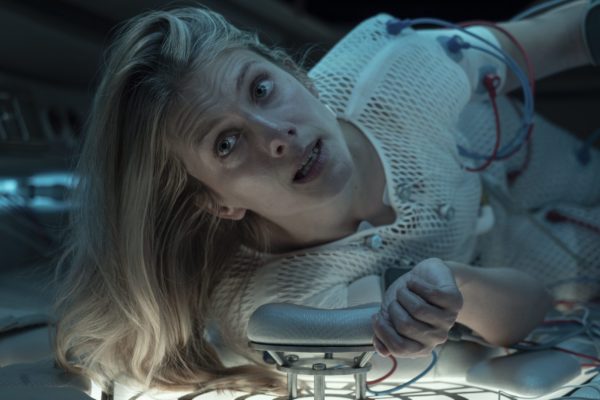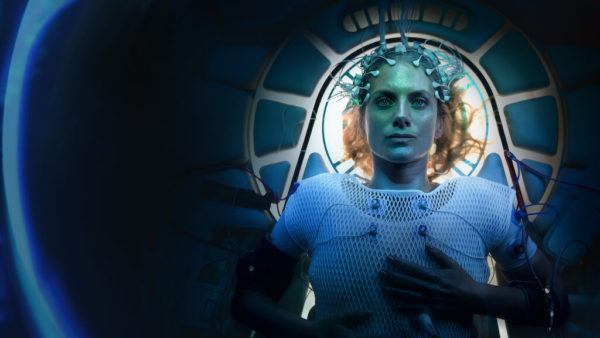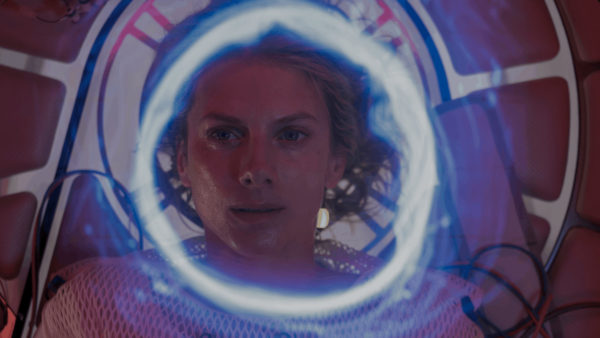
In a sealed cryogenic container with no exit, a ticking clock, and partial amnesia, what hope is there for survival in Alexandre Aja’s Oxygen?
There’s something terrifying about the idea of being trapped in a small, confined enclosure. It’s an idea that’s ripe for horror and thrills, but it’s also a challenging narrative and technical feat to successfully execute. Perhaps that’s why few recent films, the 2010 Ryan Reynolds feature Buried aside, have dedicated more than a set piece to the concept.
When approaching these kinds of narratives, questions arise: how do you avoid losing the audience’s attention? Can it be made visually engaging? Is there a danger of the action becoming redundant? Can a sense of claustrophobia be created that is entertaining but not overwhelming for viewers?
French genre director Alexandre Aja and screenwriter Christie LeBlanc have cracked the code with Oxygen, a smart, gripping thriller about a woman (Mélanie Laurent) who awakens to discover that she has been imprisoned in a cryogenic container that is losing oxygen. Technical issues with the pod aside, the woman is also experiencing temporary amnesia: she has no memory of how she got there, who locked her inside, or where it’s located.
She also doesn’t remember her own name, which causes problems when she uses the pod’s artificial intelligence, MILO (voiced with delicious impartiality by Mathieu Amalric) to call the outside world. How can you ask for help when you cannot even identify yourself? With her O2 depleting with every hyperventilating breath, the mystery woman is running out of time.

Oxygen works in large part because of its tight, tense script. LeBlanc has crafted a clever narrative that is filled with plenty of mystery (so much so that over the film’s 100 minute runtime, the revelations keep on coming right up to the climax). The film is constructed as a series of riddles and problems that the woman, who eventually discovers she is named Liz, must solve if she is to survive. Unfortunately for Liz (and exciting for the audience), each pressing issue solved inevitably opens up a new set of challenges, often involving life-threatening implications.
It’s clear from the outset that the oxygen level – which begins at 35% and drops throughout the film – is the main issue. But so, too, are the immovable locks, the mysterious woman on the phone, the police officer who isn’t saying everything, the sedative that MILO keeps trying to administer and the fact that Liz is quite literally held in place by invasive medical equipment.
That’s only a surface overview of the complications Liz must contend with, and since Oxygen is almost entirely set within a single enclosed space, the film lives and dies on Laurent’s performance.
In this capacity, Aja and LeBlanc could hardly have asked for a better actress to handle the ups and downs of Liz’s arc. Laurent is always exceptional (North American viewers will recognize the French actress from Inglorious Basterds yes, but seek out Beginners if you haven’t). It’s a real acting showcase for the actress because she’s asked to run the gamut of emotions: fear, anger, panic, love, despair, agony. You name it, and Liz goes through it…all while never achieving a vertical standing position.
Well, that’s not entirely true because Oxygen does include a few key, sporadic flashback. As Liz recovers her memories of a previous life, she sees some recurring imagery, including scenes involving a man (Malik Zidi) she knew intimately. Aja films these memories in hazy soft focus, like a beautiful fleeting dream that you can’t quite recall or trust completely. That’s a stark contrast to the cold, futuristic medical sterility of the pod in the present day.

What’s impressive is how Aja completely captures the claustrophobic, panic-inducing experience of being in the enclosed space with Liz, but it never becomes boring. Aja’s control of the space and how to move the camera within it is masterful. Take, for example, a slow repetitive 360 pan during a particularly tense sequence late in the film. It’s ostentatious, certainly, but it is also captivating and incredibly effective. It’s a testament to Aja’s talent as a director: this plays like an exciting technical exercise from a director working at the peak of his directorial prowess and the outcome is both outstanding and highly entertaining.
In addition to Aja’s constantly moving camera, the use of touch screens and holograms, the occasional mirrored surface and even frequency patterns (for phone calls and to simulate MILO’s speech patterns) help to ensure that the film is never a bland visual experience.
One (relatively small) criticism of the film is that runtime, which ultimately feels about 10 minutes too long. It’s not a deal breaker, but it’s hard not to feel a touch restless by the time the climax, when all of the mysteries and riddles have been solved and it’s do or die time for Liz, arrives.
Still, between Aja’s direction, LeBlanc’s script and Laurent’s commanding performance, Oxygen is a surprisingly energetic film experience, which is impressive considering the film is almost entirely set in a single enclosed setting. This one is worth gasping over.
4/5